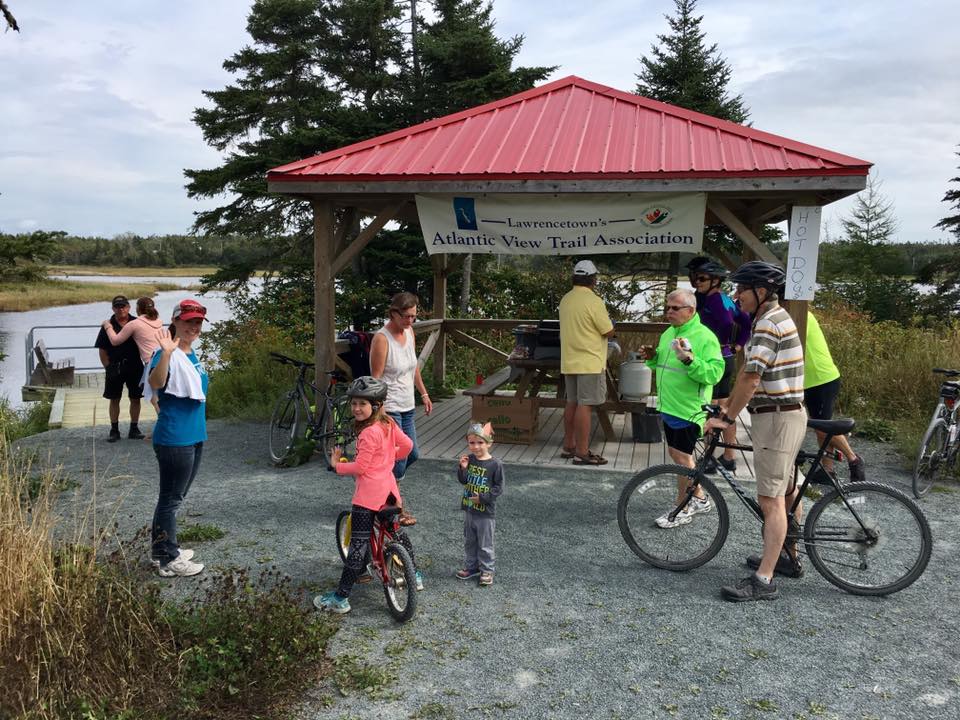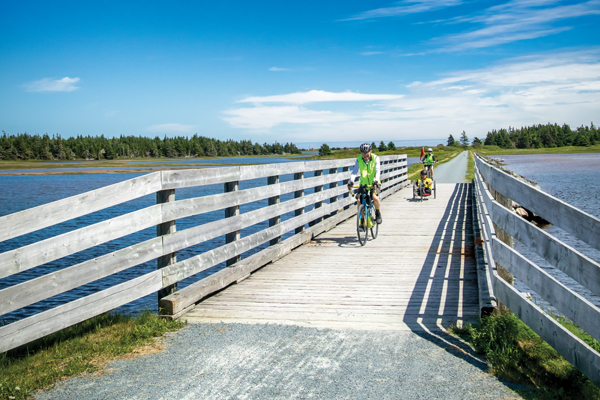When Doug MacLeod and other volunteers began work on what would become the Atlantic View Trail almost a quarter century ago, Nova Scotia’s old Eastern Shore rail line was in ruins. Alders overgrew it, ballast rock covered it, and it was almost inaccessible in some sections, with a burnt-out rail bridge and another missing decking.
It took a lot of time and labour but volunteers persevered and, from the line’s remnants, carved out a 10-kilometre trail at a cost of $1.3 million. First opened in 2007, Atlantic View is an idyllic trail boasting spectacular ocean views, nesting sea birds, horse farms, woodlands, beaches, and one of the most important surfing areas in Atlantic Canada. Part of the Cole Harbour-Lawrencetown Coastal Heritage Park, Atlantic View also passes through Lawrencetown Beach.
Mona Bordage, a keen community volunteer who works with community groups in the area, is proud to say that the Atlantic View Trail is “exceptional in its ecological diversity.”
She explains, “Along with its other unique features like surfing, you also have wind surfi ng and kayaking. There is something quite glorious about it.”
The trail’s evolution is a remarkable turnaround from 1996, when municipal amalgamation saw the area absorbed into Halifax Regional Municipality (HRM). The large rural community lacked sidewalks and its many narrow roads were often hazardous for walking or cycling. “Government and communities came together and decided that they must develop rail trails,” says Dawn Neil, the municipality’s active transportation planner.
These trails, located throughout the province where railways once ran, are the new pathways for residents to enjoy nature, the beaches, and the ocean. Now year-round roads leading to this heritage park bring thousands of residents and tourists to trails and beaches in Lawrencetown and down the Eastern Shore. It’s a resurgence of the visitation that began when trains ran this route from 1916 to the early 1980s, bringing visitors from Dartmouth and points beyond.
It wasn’t as easy as just strolling down old rail lines.
Volunteers have worked for decades to restore the rail beds and maintain them, relying on government funds. Atlantic View Trail, part of the Trans Canada Trail system, now runs from the West Lawrencetown Road to Causeway Road off Highway 207.
Doug MacLeod of West Lawrencetown was among the volunteers who made the trail’s development happen. An ardent cyclist, he enjoys using the trail system weekly, and admits building it was almost an obsession. “I thought it would be a great asset for the community,” he says.
The Provincial Parks Act and a Ministerial Order prohibit horses and motorized vehicles on the trail, which has led at times to disagreements. MacLeod says he personally wouldn’t have anything to do with a motorized trail but fears the Nova Scotian government is headed in that direction, after it announced recent changes to other trail systems.
The relationship with government is tricky for groups like MacLeod’s. Seeking funding from government for upgrades and repairs can be time consuming, he acknowledges.
Each year he spends many hours preparing funding requests because he finds that the main obstacle is a lack of co-ordination between the provincial government and HRM.
Some application forms requiring detailed information run to more than 20 pages. MacLeod estimates he puts in about 500 hours a year preparing applications, and more this year since the paperwork has become even more detailed.
In recognition of his huge time commitment, HRM recently feted Doug MacLeod at its Annual Volunteer Recognition Reception. “We recognize the extraordinary contributions of individuals and groups who volunteer their time and skills to provide services and programs in our communities,” says Councillor David Hendsbee in a recent statement.
The Atlantic View Trail runs through the Lawrencetown Beach parking area, where the province is currently working on a multi-year redevelopment, including the construction of a central pavilion, several large platforms with changing rooms, all-gender washrooms, lifeguarding facilities, and an ocean viewing platform.
Workers will build these against the backdrop of large irregular sand dunes, gouged out years ago when they provided sand and gravel for roads and bridges.
The trail’s access to the main beach is a good touchstone for visitors, offering new steel bicycle racks, along with interpretive panels of information on birds and other wildlife, as well as information about historic events like rum running and marine disasters in the area.

In addition to hiking enthusiasts, Lawrencetown Beach has long been a magnet for surfers who ride the waves throughout the year. The provincial natural-resources department built a new changing facilities particularly for the surfers who frequent “the point” at Lawrencetown Beach.
And there may be more in the works for those loyal surfers. At a meeting of trail volunteers and surfers last year, officials revealed that the provincial government is considering straightening Highway 207 at the sharp turn just above the beach, which could provide additional parking.
Any planning or changes to the Cole Harbour-Lawrencetown Provincial Heritage Park would require broad public and community input.
Meanwhile, the Atlantic View Trail volunteers have now set their sights on a new challenge — a spur off their trail’s eastern end. It will be created along a long-abandoned canal which runs from Porter’s Lake to Three Fathom Harbour.
Rocky Run at the end of Porter’s Lake couldn’t keep the lake properly drained, so in the late 1880s, workers cut a canal to Three Fathom Harbour. As the area was mostly rock, drillers, primarily former miners from East Chezzetcook, were employed, and the work took several years — as one historian put it, “especially when an election was coming up.”
Early in the 1900s, the canal was also used to transport lumber from mills on the lake to ships in the harbour.
Last year the Atlantic View Trail volunteer group received permission from the province to construct a 500-metre trail along the canal to the lake shore where a picnic site will be located.
Volunteers gathered on the trail last fall and walked to Porter’s Lake to get their first look at the challenges that lie ahead. They were somewhat taken aback at the work required to build the extension but also with a feeling of anticipation of another addition to their beloved trail.
And while the work never ends, the future is promising, because government’s days of looking at trails as nice-to-have but not essential community infrastructure are waning.
“Now they have become a major part of the transportation network,” Dawn Neil says.
